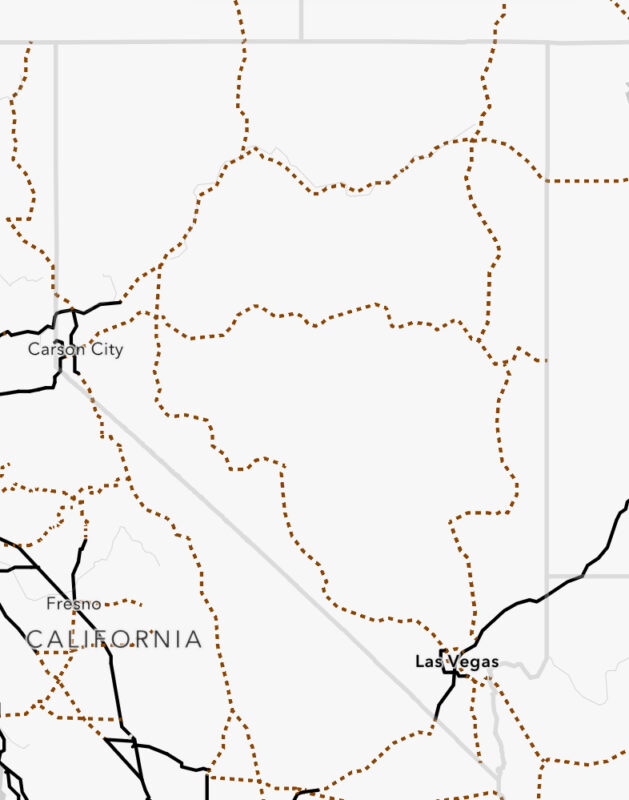Sign up for daily news updates from CleanTechnica on email. Or follow us on Google News!
If you look at a map of CCS chargers in rural Nevada, you’ll notice that there are stations all over, and in many places away from the interstate that Tesla hasn’t touched yet. While this was a great development for EV drivers trying to visit places like Area 51 and Great Basin National Park, things have since gone horribly wrong, with many of the stations in poor repair. As we watch the charging industry expand into more of rural America, the story of what happened here holds some important lessons.
Dieselgate
In a number of western states, there simply wasn’t any rural fast charging for a long, long time. Before Electrify America covered the interstates, the only way to drive something like a Nissan LEAF or a Chevy Bolt between major metros was to camp out at RV parks or even run an extension cord out under the door of a motel room!
From 2012 to around 2019 this was a real Catch-22. Private industry had no real interest in changing this situation. After all, hardly anybody owned EVs in those areas, so why would anyone want to spend tens of thousands of dollars to build a station for them? But, people who traveled in these areas, buying an EV seemed like a bad idea because there was nowhere to charge them away from home.
The first big break for non-Tesla charging outside of major metros came from an ironic source: the Dieselgate scandal. After getting caught cheating on emissions with sophisticated engine computer software that would nerf the engine when it could tell the vehicle was placed on an emissions testing dyno, the company faced major fines from the US government and prison time for some in the company.
As part of the final settlement, the company had to spend $10 billion building EV chargers. This resulted in the creation of the Electrify America company and the building of stations along many interstate highways. This made things a lot easier for EV drivers who couldn’t access Tesla’s superchargers.
But, one thing many people don’t know is that many other EV chargers have come from the Dieselgate settlement. Another part of the agreement involved paying the states large sums of money that could be used to help remediate the environmental impacts of the cheating diesel cars. States spent a portion of this money on the building of charging stations, and some of them have spent a lot of it on rural EV charging. This is an ongoing project today in a number of states.
Nevada’s Rural EV Charging Program
Things looked great in 2016 when the state began work on its “Electric Highway.” The goal? Make it possible to drive from Vegas to Reno with an EV. But during the initial ceremony opening up one of the stations, the state had trailered in a vehicle that couldn’t have gotten there from Vegas. According to an AP article a week ago, this was a sign of things to come.
Away from I-95, Dieselgate money provided a much-needed boost in 2018 to start building stations all over the state. This was where most of the rural stations in the desert lowlands of Nevada came from. These stations opened up most of the states to EVs, and made a large positive difference.
But today, there’s a big problem: the stations are busted. Most of them seem to have been Greenlots stations, which have been bought by Shell ReCharge. Some of them have been abandoned, while others have a less than 10 rating on PlugShare (which is a good sign of serious problems). Because Shell didn’t build these stations, they don’t seem to be a high priority for maintenance.
The original Nevada Electric Highway office closed its doors in 2023, so now there’s really nobody working to light a fire under the butts of the companies that own and operate them.
It’s worth noting that many other states have had similar problems, so it wouldn’t be fair to say that this is a problem unique to The Silver State. The approach of taking bids or otherwise awarding funds and then forgetting about the stations just doesn’t work.
Light At The End Of The Tunnel
The Infrastructure Bill is probably going to save EV charging in Nevada in two ways.

First off, the NEVI program (the one that requires at least 4-stall 150 kW EV charging stations every 50 miles) will allow for the replacement of some of these stations. This will happen over the next 10 years or so, and it will cover the same highways that currently have busted charging stations. This will mean that the main highways considered alternative fuel corridors get covered.
The other thing that will help are discretionary programs in the Infrastructure bill that allow the federal DOT to grant money for things like charger repairs, covering dead zones, and otherwise further improving the network. Some of these stations could be improved or upgraded using those funds.
What Nevada (& Other States) Should Do
On top of getting federal help, the state should consider taking other action to get these stations running right. While the money meant to build them has already been spent, it really wouldn’t take all that much to get them working better. The power to the sites has already been put in. The stations have been installed. All of the really expensive and time-consuming stuff has happened. Setting aside some money to get the manufacturers to refurbish these machines and maybe put better components in them could go a long way toward getting things going again.
But, sending good money after bad should also be avoided. Money to fix these up should come with some standards attached. Companies fixing these up should be required to sign up for a service plan with the hardware provider so that they can stay up and running for years. Proactive monitoring and testing should be required, and stations should get fixed quickly. There will be costs involved, yes, but they can be included in whatever bill the state can pass to fund it.
It makes no sense to flush the money that was spent putting these stations in down the drain just because NEVI will eventually replace them.
Featured image: a screenshot from PlugShare showing Nevada’s CCS charging stations.

Have a tip for CleanTechnica? Want to advertise? Want to suggest a guest for our CleanTech Talk podcast? Contact us here.
Latest CleanTechnica.TV Videos
CleanTechnica uses affiliate links. See our policy here.
CleanTechnica’s Comment Policy





